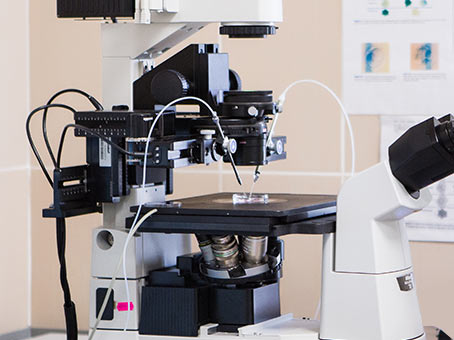
Intracytoplasmic Sperm Injection ICSI

Intracytoplasmic sperm injection (ICSI) is one of the assisted methods of artificial insemination (IVF). In ICSI, the physician directly introduces one viable spermatozoon into the cytoplasm of the ootid by using micromanipulators. The method features a high chance of pregnancy even in cases of an incurable form of infertility in men.
- Indications for ICSI:
- Preparing for ICSI
- Stages of ICSI
- What Defines the Effectiveness of the ICSI?
- Cost of ICSI Services in the USA
Preliminary and subsequent stages of ICSI insemination are exactly the same as with classical in vitro fertilization; the only difference is the insemination technique. For ICSI, only one spermatozoid per ovum is needed, while classical IVF involves using 50,000 to 100,000 spermatozoa. After the fertilization, the egg becomes a pre-embryo and is transferred into the uterine cavity for its further development.
Indications for ICSI:
Of course, it is a doctor who decides what type of IVF will work the best in a particular case. Here are some of the indications for undergoing ICSI procedure:
- spermogram of poor quality;
- unsatisfactory result of fertilization in previous attempts of in vitro fertilization;
- the age of a woman is over 40;
- the number of oocytes is 4 or less;
- immunological infertility.
Based on these data, the doctor decides when and if to apply for icsi fertility treatment.
Preparing for ICSI
Preparation for ICSI is exactly the same as that for IVF. The woman is prescribed to take hormonal treatments to stimulate the ovaries. Of course, it is possible to conduct ICSI in a natural cycle. However, in this case, the number of eggs obtained for fertilization will be minimal (one or two), which greatly reduces the probability of procedure success. And since ICSI cost is quite high, performing the manipulation in the natural cycle is extremely rare and can happen in exceptional cases.
Stages of ICSI
Just like any other type of in vitro fertilization, ICSI is performed in several stages – each focused on a particular manipulation.
- Control and Stimulation of the Ovaries
For the production of eggs, the ovaries are stimulated by daily intake of hormones for 2 or 3 weeks. The level of hormones and the development of follicles (vesicles with oocytes) in the ovaries are closely monitored by the doctor. When the right amount of follicles of the appropriate size is produced, the day of their extraction is assigned.
- Egg Extraction and Fertilization
The extraction of eggs is performed by puncturing and aspirating the follicles. This procedure is carried out with the patient being under sedative anesthesia. After extraction, follicles are placed in the nutrient medium for several hours, while the semen is prepared for the separation of the mobile spermatozoa. Only afterwards the eggs are prepared for the fertilization with the outer layer of the surrounding cells being removed. By means of an intracytoplasmic injection, the sperm is introduced into each of them.
- Transferring
In two or three days, fertilized eggs will turn into pre-embryos, ready for being transferred into the uterus. The “best” ones are taken into a thin catheter and inserted into the uterus. Anesthesia is not required for the procedure. When transferring pre-embryos, only one of them is implanted, but one must bear in mind that in some cases, several pre-embryos can be transferred, which can lead to multiple pregnancies.
- Cryopreservation
The remaining pre-embryos are frozen in liquid nitrogen and put in the embryo bank, with preliminary identification by marking. The material can be used in subsequent cycles if pregnancy does not occur at the first attempt of icsi type of ivf. Undoubtedly, the therapy for preparing the uterus for the transfer of frozen embryos is simpler, since it is not necessary to stimulate or extract the eggs for the fertilization.
Our Customer Service Representatives are eager to help you with whatever you need.
What Defines the Effectiveness of the ICSI?
Considering the ICSI treatment cost, one wants to be sure of the procedure success. Just like in anything in life, it is impossible to know how things will go in the future. With ICSI 2017, several factors influence the effectiveness of the procedure.
- Preparation of mobile spermatozoa from the testis or from the seminal fluid;
- The presence of quality oocytes in a woman;
- The complete absence of motile spermatozoa and globosoospermie.
The severity of male infertility does not affect the probability of the successful manipulation. Also, the number, morphology, and motility of spermatozoa have no effect on the effectiveness of the ICSI procedure.
Cost of ICSI Services in the USA
ICSI cost in USA clinics ranges from $12,000 to $20,000, depending on what procedures you will need to undergo and what service package you choose. Usually the final amount depends on the amount of diagnostic studies, the need for medical procedures, the choice of the fertilization method, and additional services. For example, the choice of a child's sex costs $ 4,500. Far from every couple can afford it. Therefore, many people search an alternative to save money; going to Ukraine can be a solution. The thing is that ICSI cost in Ukraine is considerably low and amounts to approximately $3,500 (depending on a clinic you choose). The cost covers all the services as well as pre-ICSI examinations.
- Surrogate motherhood - how not to be deceived
- Advantages of guaranteed surrogacy programs over programs with guaranteed compensation
- Surrogacy in Mexico: What You Need to Know
- Disadvantages of Egg Donation - Only Truth about the Procedure
- Unique Cases of Giving Birth to Children
- ICSI, PICSI and IMSI methods, what is the difference and differences?
- ICSI procedure: features and possibilities
- What Is The Difference Between IVF And ICSI?
Join my mailing list to receive the latest news and updates

